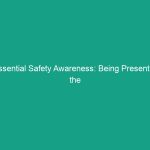Introduction
The installation of roofing materials is a critical task in construction and building Maintenance that requires strict adherence to health, safety, and environmental (HSE) standards. The potential Hazards involved, including falls, injuries from equipment, and exposure to harmful substances, make it essential to prioritize Safety at every step of the process. The safe installation of roofing materials not only protects the workers involved but also ensures the longevity and integrity of the roofs being installed. In this article, we will explore the importance of HSE in roofing installations, share practical tips for maintaining Safety, and discuss the regulatory frameworks that govern these practices.
Understanding Regulatory Frameworks
Regulatory frameworks play a significant role in ensuring safety Standards are maintained during the installation of roofing materials. Various organizations and government bodies set forth guidelines that must be adhered to, which can vary from one region to another. Familiarizing yourself with local, state, and federal Regulations is crucial to achieving compliance and enhancing Workplace Safety.
OSHA Standards
The Occupational Safety and Health Administration (osha) in the United States provides comprehensive guidelines specifically for construction work, including roofing. These standards address Fall Protection, Ladder Safety, scaffolding, and Electrical Safety, which are all critical when installing roofing materials. For instance, OSHA mandates that workers on roofs over six feet high must use fall protection systems, which can include guardrails, safety nets, or personal fall arrest systems.
Local Building Codes
In addition to OSHA regulations, local building codes often include specific requirements for roofing installations. These codes ensure that roofing structures can withstand environmental conditions and that they are installed correctly to prevent future issues. It’s crucial for contractors to understand these codes and ensure compliance before commencing work.
Environmental Regulations
When discussing the safe installation of roofing materials, one must also consider environmental regulations. Certain materials may require specific handling and disposal methods to minimize environmental impact. For example, asbestos-containing materials are heavily regulated due to their health risks. Familiarity with these regulations helps in selecting appropriate materials and methods for roofing projects.
Best Practices for Safe Installation
Implementing Best Practices during the installation of roofing materials can significantly reduce the risk of accidents and injuries. These practices not only protect workers but also enhance the overall quality of the roofing project.
Pre-Installation Safety Assessments
Before beginning any roofing project, conducting a thorough safety assessment is essential. This includes evaluating the work site for potential Hazards, such as unstable surfaces, nearby electrical lines, or weather conditions that could affect safety. Engaging in this proactive approach allows teams to devise strategies to mitigate identified risks effectively.
Use of Personal Protective Equipment (PPE)
Providing and enforcing the use of Personal Protective Equipment (PPE) is another crucial aspect of the safe installation of roofing materials. Workers should be equipped with hard hats, safety glasses, gloves, and non-slip footwear. Additionally, fall protection gear, such as harnesses and lanyards, should be mandatory for all workers operating at heights.
Training and Education
Regular Training and education on safety practices are vital in keeping workers aware of the latest safety protocols and equipment. This training should cover the proper use of tools, hazard recognition, and emergency response Procedures. By ensuring that all team members are knowledgeable about safety practices, companies can foster a culture of safety that permeates every aspect of their operations.
Tool and Equipment Safety
Proper maintenance and handling of tools and equipment are essential to prevent accidents during roofing installations. Regular inspections should be conducted to ensure that all tools are in good working condition, and workers should be trained on the correct usage of each tool. For example, using the right ladder for roof access and ensuring it is set up correctly can prevent falls and injuries.
Weather Considerations
Weather can significantly impact the safety of roofing installations. High winds, rain, or extreme heat can create hazardous conditions. It is crucial to monitor weather forecasts and delay work when conditions are unsafe. Workers should be educated about recognizing signs of dangerous weather and the appropriate actions to take, such as evacuating the site or securing materials.
Case Studies: Learning from Real-World Examples
Examining case studies of past roofing projects can provide valuable insights into the challenges and solutions related to safety in roofing installations. These examples often highlight both successes and failures, offering lessons that can be applied to future projects.
Case Study: Successful Safety Implementation
A roofing company in New York implemented a comprehensive safety program that included detailed safety assessments, regular training sessions, and the use of advanced fall protection systems. As a result, they reported a 60% reduction in on-site accidents over two years. This case demonstrates that a proactive approach to safety not only protects workers but also improves overall productivity and reduces costs related to accidents.
Case Study: Lessons from Failures
Conversely, a roofing project in Texas faced significant challenges due to inadequate Safety Measures. Workers were not provided with proper fall protection, and a sudden gust of wind led to a serious accident. This incident resulted in injuries and legal repercussions for the company. The fallout from this case emphasizes the importance of adhering to safety regulations and implementing Best Practices during roofing installations.
Challenges in the Industry and Solutions
While many companies strive for safe installation of roofing materials, several challenges can hinder these efforts. Understanding these challenges and identifying solutions is crucial for enhancing safety in the roofing industry.
High Turnover Rates
The roofing industry often faces high turnover rates, which can lead to a lack of experienced workers on the job site. New employees may not be familiar with safety protocols, increasing the risk of accidents. To combat this issue, companies should consider establishing mentorship programs where experienced workers guide newcomers, ensuring they are adequately trained in safety practices.
Material Handling Hazards
Handling and transporting roofing materials can pose significant safety risks, especially when dealing with heavy or sharp items. Companies should implement strategies for safe material handling, such as using hoists or cranes for heavy loads and ensuring that all workers are trained in safe lifting techniques. Additionally, using materials with safer profiles can minimize risks associated with handling.
Communication Gaps
Effective communication is vital in maintaining a safe work Environment. Miscommunication can lead to accidents, especially in larger teams where multiple trades are involved. Regular safety meetings and clear signage on the job site can help bridge communication gaps. Establishing a culture of open dialogue encourages workers to voice safety concerns and report hazards without fear of repercussions.
Future Trends in Roofing Safety
As the roofing industry continues to evolve, several trends are shaping the future of safety in the installation of roofing materials. Staying informed about these trends can help companies adapt and enhance their safety practices.
Increased Use of Technology
The integration of technology in roofing safety is on the rise. Drones are being utilized for site inspections and monitoring, while augmented reality (AR) is being explored for training purposes. These technologies can improve safety by allowing for better planning and risk assessment without putting workers in hazardous situations.
Focus on Mental Health
In recent years, the focus on mental health in the workplace has gained traction. Acknowledging the mental well-being of workers is essential for fostering a safe work environment. Programs that promote mental health awareness and provide support can lead to a more engaged workforce, ultimately enhancing safety outcomes.
Green Roofing Practices
As Sustainability becomes increasingly important, the adoption of green roofing practices is on the rise. These practices not only benefit the environment but can also improve safety by utilizing lighter materials and innovative design techniques. Training workers on sustainable practices can further enhance their skill sets while promoting safety.
Conclusion
The safe installation of roofing materials is paramount in protecting the health and safety of workers and ensuring the integrity of structures. By understanding regulatory frameworks, implementing best practices, learning from case studies, and addressing industry challenges, roofing professionals can foster a safer work environment. As the industry continues to evolve, embracing new technologies and focusing on mental health will play a crucial role in enhancing safety standards. It is imperative for all stakeholders to prioritize safety, as it not only protects lives but also contributes to the long-term success of roofing projects. Take the necessary steps today to ensure the safety of your roofing installations and contribute to a culture of health and safety in the construction industry.


